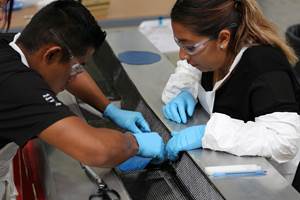TAVieDA project team cuts aircraft door production time using thermoplastic composites, welding
Fraunhofer groups, Trelleborg and Airbus develop modular, fully automated assembly system concept to replace metals and time-consuming assembly that shows potential for scalability.
Share
Clamping element developed at Fraunhofer IWU for automated clamping and joining of thermoplastic carbon fiber composites in aircraft doors (such as a crossbeam). Source (All Images) | Fraunhofer IWU
The TAVieDA research project by the Fraunhofer Institute for Machine Tools and Forming Technology (IWU, Chemnitz, Germany), the Fraunhofer Institute for Structural Durability and System Reliability (LBF, Darmstadt), Trelleborg (Sweden) and Airbus Helicopters (Marignane, France) demonstrates how replacing aluminum, titanium and thermosets primarily with carbon fiber-reinforced thermoplastic polymers (CFRTP) can reduce the manufacturing time for passenger aircraft doors.
Aircraft doors are still primarily manufactured by hand. A particularly time-consuming aspect is assembling the door structures using screws and rivets. Numerous intermediate steps are required to prevent direct contact between different materials — which would otherwise lead to corrosion. Using CFRTP primarily could weld these structures together automatically without separating layers, partners note, dropping manufacturing time from 110 hours to 4 hours.
Learn more about thermoplastic composites welding here.
Another key factor in shortening assembly times is the modular design for different aircraft door variants. The project team specifically looked for components across various door models that could be standardized — and found success, for example, with the crossbeam. The researchers designed a fully automated assembly line for the most common models and developed fixtures and clamping elements suitable for resistance and ultrasonic welding technologies.
“Together with our colleagues at Airbus, we closely analyzed all door structures to adapt the geometries for automatic clamping and joining,” says Dr. Rayk Fritzsche, project lead at Fraunhofer IWU. “As a result, we could reorganize and fully automate the individual assembly steps. This way, we slash the lead time to a fraction of what it used to be.” Manual labor is now only required to install the locking mechanism.
Two almost identical assembly and joining lines ensure redundancy if one line is unavailable. Thanks to standardization measures, batches of 10 doors can now be organized, enabling fully automated line retooling at the end of each shift to accommodate the following model series. With a production capacity of 4,000 doors per year, partners agree that the new material and production concept leads to significant scalability benefits.
As part of a new approach, cost modeling was integrated directly into the simulation environment, allowing for simultaneous calculation of unit costs alongside simulation results.
Maxi Grobis, from IWU’s factory planning, simulation and evaluation team, simulated all technical and economic aspects of the new assembly line —factors that often influence each other. Key technical assessment criteria included product and process complexity, opportunities and risks of automation (especially concerning flexibility and adaptability), and overall system availability across a chain of individual automated systems.
Automating just for automation’s sake wasn’t an option. “To deliver a truly integrated solution, we analyzed the entire door production and assembly process and translated it into a dynamic cost model,” Grobis emphasizes. “What works technically also has to make sense in terms of capital expenditure, machine hourly rates, maintenance effort, energy costs, capital commitment and depreciation. Focusing solely on labor cost savings or shorter lead times would be shortsighted.”
Considering all technical, logistical and financial factors, there is a clear recommendation to implement the newly developed automation solution. Grobis notes that her integrated simulation approach also reduced planning time by about 25%.
“Thinking about economics from the beginning saves unnecessary revision loops during planning,” she concludes.
Related Content
Plant tour: Airbus, Illescas, Spain
Airbus’ Illescas facility, featuring highly automated composites processes for the A350 lower wing cover and one-piece Section 19 fuselage barrels, works toward production ramp-ups and next-generation aircraft.
Read MoreFilament winding increases access to high-performance composite prostheses
Steptics industrializes production of CFRP prostheses, enabling hundreds of parts/day and 50% lower cost.
Read MoreComposites manufacturing for general aviation aircraft
General aviation, certified and experimental, has increasingly embraced composites over the decades, a path further driven by leveraged innovation in materials and processes and the evolving AAM market.
Read MoreCarbon fiber, bionic design achieve peak performance in race-ready production vehicle
Porsche worked with Action Composites to design and manufacture an innovative carbon fiber safety cage option to lightweight one of its series race vehicles, built in a one-shot compression molding process.
Read MoreRead Next
Design for manufacturing, assembly and automation enables complex CFRP telescope supports
Airborne delivered two mirror support structures for the FYST and SOLAT telescopes, assembling 26,300 components while maintaining near-zero CTE, strict tolerances on 6.5 × 6.5 × 1.8-meter assemblies.
Read MoreAssembling the Multifunctional Fuselage Demonstrator: The final welds
Building the all-thermoplastic composite fuselage demonstrator comes to an end with continuous ultrasonic welding of the RH longitudinal fuselage joint and resistance welding for coupling of the fuselage frames across the upper and lower halves.
Read MoreMM-Welding solution automates, functionalizes composite joining
Ultrasonic joining has been used for decades, but is now being advanced to enable smart, automated fastening in composites and multi-material assemblies.
Read More









